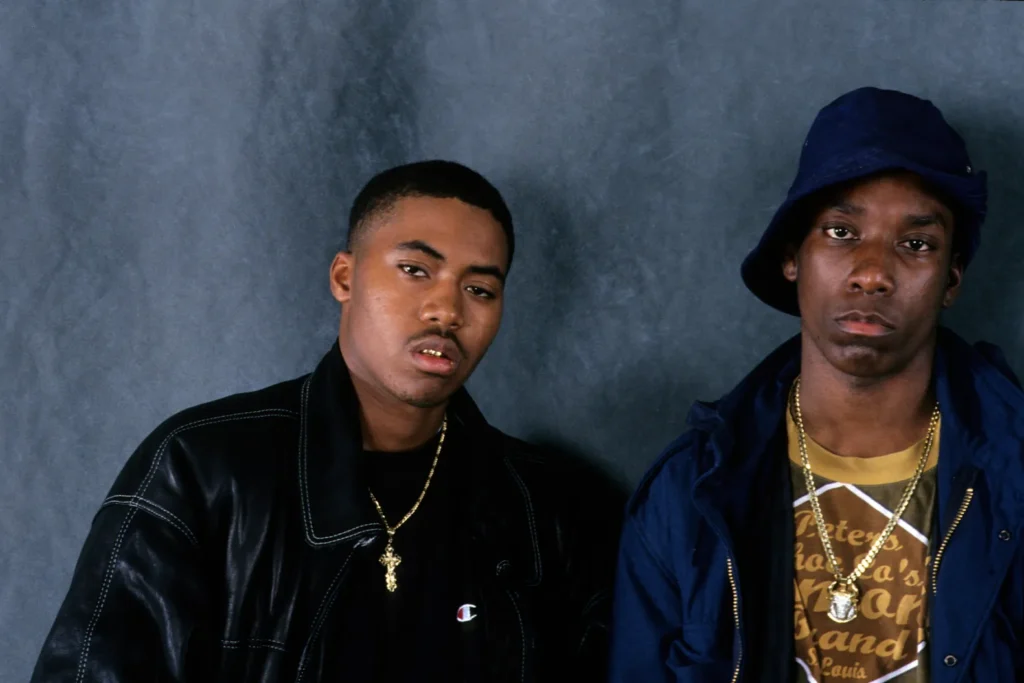
Rappers Nas (left) and Big L in a portrait taken on Nov. 10, 1994, in New York City
If ever there was a phantom presence in hip-hop that still reverberates down Harlem’s Lenox Avenue and the Queensboro Bridge alike, it’s Big L. Now, nearly three decades after the tragic loss of the Harlem wordsmith, his estate and the team at Mass Appeal Records have delivered a project that finally tries to close the gap between myth and legacy: Harlem’s Finest: Return of the King.
A Statement of Intent
This isn’t just another posthumous hustle. Built from remastered verses, rare freestyles, and a few powerful surprises, the album reinforces the late talent’s legacy by presenting his catalog in the sharpest and most cohesive form possible.
Under the watchful eye of Big L’s family and longtime collaborators, the project was executed with one goal: to ensure every bar and every breath still carries that Harlem edge.
The Collabs & Cultural Cross-Sections
Big L Finally Connects with Nas
On “U Ain’t Gotta Chance,” we hear something truly seismic — Big L and Nas trading airwaves 26 years in the making. Nas admitted that Big L’s raw energy and technical precision once had him “scared to death.” The track resurrects a 1997 freestyle by L, pairing it with new-era production from G Koop, 2one2, Al Hug, and Mike Heron, while Nas drops a present-day verse on top of vinyl-aged bars from the Harlem OG.
A Deeper Roster of Guests
But this album isn’t riding only on one moment. The tracklist pulses with Harlem pride — songs like “Harlem Universal,” “RHN (Real Harlem N**gas),” and “Fred Samuel Playground” evoke the block, the corner philosophy, and the bounce of 139th & Lenox.
Other confirmed names include Jay-Z, Method Man, Mac Miller (via estate clearance), and Joey Bada$$. One standout moment is “Forever,” which pairs Mac Miller and Pale Jay alongside Big L’s vocals — a cross-generational bridge built on respect.
The Producers & Curators
The executive producer seat is held by Royce da 5′9″, who brought in a stable of collaborators — Lord Finesse, EZ Elpee, Malay, and Beat Butcha — to maintain the analog crackle, the cypher-room warmth, and the microphone-breath immediacy of Big L’s ’90s prime.
Why This Matters
Preservation Over Packaging
In a landscape littered with posthumous releases, this one stands apart for the care in curation. Big L’s estate, the label, and the producers opted not for flashy features or hollow alignments, but for focus, brevity (under 40 minutes), and authenticity.
A New York Lineage Reaffirmed
This album is Harlem through and through, but it also gives us a portal to Queens (via Nas), Staten Island and Brooklyn (via Jay-Z), and beyond. The blueprint Big L laid in the ’90s — multisyllabic rhyme patterns, punchline-heavy sheets, corner-to-city perspective — they’re all studied now. Big L remains rap’s eternal study guide.
Context & Closure
It’s impossible to dissociate this album from Big L’s tragic early passing in 1999 at age 24. His original debut, Lifestyles Ov Da Poor & Dangerous (1995), had him rising; this new album is, for many, the final chapter — his story told on his own turf.
The Takeaways — For the Culture & the Streets
-
Legacy Realised: Big L’s voice isn’t just archived — it’s reanimated. The album’s brief runtime delivers potency over filler.
-
Fresh Meets Classic: The collision of old freestyles with new production and guest voices doesn’t feel gimmicky — when done right, it honors, not hijacks.
-
Harlem Reigns: From the title to the samples to the bars, the spirit of Harlem — tough, witty, unapologetic — runs through it all.
-
Lyricism as Art: As Nas put it, this album reminds us it’s not about hype — it’s about art.
-
A Blueprint for Posthumous Care: The estate’s control, the sample clearances, the real collaborators — they set a new standard.
Final Word
Harlem’s Finest: Return of the King isn’t simply a nostalgic throwback — it’s a reclamation. Big L didn’t just leave bars; he left an ethos, and this album turns that ethos into action. For the heads who remember the corner cyphers, for the new school chasing punchlines over clout, and for the culture kids who lean on New York’s hip-hop lineage — the crown returns.
When the needle drops and the reel starts spinning, the man who once made Nas nod and other emcees pause steps back into the spotlight, microphone blazing, Harlem in his breath, legacy in his bars. And for that, the city still listens.
